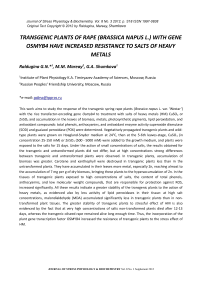Transgenic plants of rape (Brassica napus L.) with gene Osmyb4 have increased resistance to salts of heavy metals
Автор: Raldugina G.N., Mareay M.M., Shumkova G.A.
Журнал: Журнал стресс-физиологии и биохимии @jspb
Рубрика: Supplement
Статья в выпуске: 3 т.8, 2012 года.
Бесплатный доступ
Transgenic, brassica napus, osmyb4, heavy metals, accumulation, stress
Короткий адрес: https://sciup.org/14323635
IDR: 14323635
Текст статьи Transgenic plants of rape (Brassica napus L.) with gene Osmyb4 have increased resistance to salts of heavy metals
Journal of Stress Physiology & Biochemistry, Vol. 8 No. 3 2012, p. S18 ISSN 1997-0838 Original Text Copyright © 2012 by Raldugina, Mareay , Shumkova
TRANSGENIC PLANTS OF RAPE (BRASSICA NAPUS L.) WITH GENE
OSMYB4 HAVE INCREASED RESISTANCE TO SALTS OF HEAVY METALS
Raldugina G.N.*1, M.M. Mareay2, G.A. Shumkova1
1Institute of Plant Physiology K.A. Timiryazev Academy of Sciences, Moscow, Russia
2Russian Peoples' Friendship University, Moscow, Russia
This work aims to study the response of the transgenic spring rape plants ( Brassica napus L. var. ‘Westar’) with the rice transfactor-encoding gene Osmyb4 to treatment with salts of heavy metals (HM) CuSO 4 or ZnSO 4 and accumulation in the leaves of biomass, metals, photosynthetic pigments, lipid peroxidation, and antioxidant compounds: total phenols, anthocyanins, and antioxidant enzyme activity superoxide dismutase (SOD) and guaiacol peroxidase (POX) were determined. Vegetatively propagated transgenic plants and wildtype plants were grown on Hoagland-Snyder medium at 24°C, then at the 5-6th leaves-stage, CuSO 4 (in concentration 25-150 mM) or ZnSO 4 (500 - 5000 mM) were added to the growth medium, and plants were exposed to the salts for 15 days. Under the action of small concentrations of salts, the results obtained for the transgenic and untransformed plants did not differ, but at high concentrations strong differences between transgenic and untransformed plants were observed. In transgenic plants, accumulation of biomass was greater. Carotene and xanthophyll were destroyed in transgenic plants less than in the untransformed plants. They have accumulated in their leaves more metal, especially Zn, reaching almost to the accumulation of 7 mg per g of dry biomass, bringing these plants to the hyperaccumulation of Zn. In the tissues of transgenic plants exposed to high concentrations of salts, the content of total phenols, anthocyanins, and low molecular weight compounds, that are responsible for protection against ROS, increased significantly. All these results indicate a greater stability of the transgenic plants to the action of heavy metals, as evidenced also by less activity of lipid peroxidases in their tissue: at high salt concentrations, malondialdehyde (MDA) accumulated significantly less in transgenic plants than in nontransformed plant tissues. The greater stability of transgenic plants to stressful effect of HM is also evidenced by the fact that at very high concentrations of salts non-transformed plants died after 12-13 days, whereas the transgenic oilseed rape remained alive long enough time. Thus, the incorporation of the plant gene transcription factor OSMYB4 increased the resistance of transgenic plants to the stress effect of HM.
JOURNAL OF STRESS PHYSIOLOGY & BIOCHEMISTRY Vol. 8 No. 3 Supplement 2012


